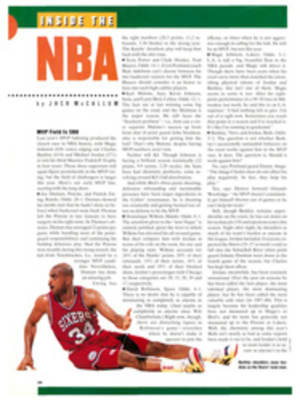
Still Head of the Class
The cabbie taking passengers from the Sky Harbor International Airport to downtown Phoenix had a little inside joke, which he pulled on race fans and participants trying to get to the Grand Prix of the United States. "So, you want to go to the Grand Canyon," the hack would say, and then chuckle at his fare's puzzlement.
But a deep, empty hollow is what downtown Phoenix might as well be during the only U.S. race on the 16-event Formula One world championship circuit, and the season opener. Appreciation for the race may be intense abroad—Formula One events are televised to 300 million people in 76 countries—but in Phoenix the interest in it can fit in the back of a pickup truck. After three years in Arizona, the sport and the venue remain entirely foreign to each other.
Sky-high technology and canyon-deep subterfuge make Formula One racing unique, which is why the argument is sometimes advanced that it's not a sport as much as an engineering exercise, a global marketing program and a cutthroat business affecting and reflecting the economic strength of entire countries. The drivers have more in common with the allied fighter pilots who were active in the Persian Gulf than they do with other professional athletes, except for one thing: Formula One drivers are paid like Saudi Arabian princes. World champion Ayrton Senna of Brazil makes about $1 million per race.
This season marks the beginning of the fourth year of the fiercest drivers' duel ever witnessed in Grand Prix racing. Between them, Senna and Alain Prost of France had won 36 of 48 races going into Phoenix—Senna 20, Prost 16. Prost was champion in '85, '86 and '89, Senna in '88 and '90. Senna is the fastest driver in the history of Formula One—he has been on the pole for 53 Grands Prix as a result of being quickest in qualifying; Prost is the winningest driver ever, with 44 victories. They do not like each other. Only the two men know the depth of their animosity, but it's not something they explore, because to do so would distract them from attempting to defeat the other. By necessity, their relationship is filled with respect for each other's talent behind the wheel, but at the same time it is a relationship simmering with fury. Sometimes it boils over in frightening ways.
Last year their battle for the world championship was brutal, ending on the first turn of the first lap on the Suzuka circuit in Japan, in the season's penultimate race. While traveling 150 mph, Senna jammed his McLaren-Honda into Prost's Ferrari, knocking them both out of the race and thereby assuring himself the world championship. Moreover, the crack-up was a remake, if not a repeat, of the 1989 finish at Suzuka, when—as McLaren teammates—Senna and Prost had crashed in much the same manner. That time Senna finished, but he was subsequently disqualified (and later fined $100,000 for bad-mouthing the decision), which gave Prost the championship.
In Phoenix on Sunday, Prost and Senna, winners there in 1989 and '90, respectively, started side by side on the front row. That, however, was as close as they would come to each other. Senna left Prost in the black dust of his Goodyears, averaging 98.018 mph for 81 laps of the 2.35-mile circuit. It was a trouncing made all the more remarkable by the fact that Senna's McLaren-Honda V-12 was a new design that had never turned a wheel before practice on Thursday. Prost would come in a distant second, 16.322 seconds back, which gave the 18,500 fans almost nothing in the way of close racing.
Senna, 30, is probably the most complex world champion in the history of Grand Prix racing. Certainly he is the most obsessed. Says his team manager, Ron Dennis, "I've spent my life dealing with overachievers, and I've never seen anyone like Senna."
Senna is a concentration machine. So dedicated is he to his pursuit of speed that he seemingly rejects all else, including consideration of others. Rude and arrogant are adjectives that are often applied to him. He seems to have no time for anyone who can't show him how to go faster. When he is at work, he is given to tears and angry outbursts, but rarely over technical matters; he almost never blames his car for a loss. His emotions surface when he is hurt or affronted by another driver or by race officials. Senna is not without a sense of humor, but he displays it nearly as infrequently as he smiles. "I am very happy inside," he says.
In the selfish world of Formula One drivers, Senna is far the most selfish on the track. He believes that other drivers should give way, simply because he is who he is. They should know he will be there. Such an attitude is blindly self-centered and unrealistic, yet it has undoubtedly been a key factor in what is a brilliant career.
Nelson Piquet, a fellow Brazilian and a three-time world champion, has feuded with Senna, too. It got to the point that Piquet implied that Senna, who is a bachelor, may be gay. Senna was outraged and threatened to sue Piquet. Since then, he has made a point of being seen in the company of beautiful women.
Senna is a born-again Catholic, and he often retreats to the back of his team's luxurious motor home with his Bible. He claims to have seen Jesus at Suzuka in 1988, a race in which he stalled at the start but came back to win, and to have been guided by the voice of God at Monaco in '90, when he fended off a late charge by Jean Alesi to win the most famous Grand Prix of them all.
Senna travels between races and continents in his $10 million jet and goes back to one of his three homes in Brazil whenever he can. He was so drained by the travails of last season, especially by what happened in Japan, that he relaxed on his farm for two months. The only distraction was an attempt to kidnap him in November, but it was foiled by the police.
Whoever the real Senna may be, Prost has had enough of the one he knows. Prost, 35, who is called the Professor because of his textbook driving style, believes that Senna is a blemish on the sport, that he has corrupted the driving ethic. Prost left Team McLaren after '89 to get away from Senna (a reported $9 million signing bonus and $15 million-a-year salary from Ferrari probably did a lot to salve the pain of separation), and he almost quit Formula One entirely at the end of last year because of "all the— —" associated with Senna. But Prost re-upped with Ferrari, encouraged by the promise of a newly designed 12-cylinder engine.
It's a shame Phoenix drew so few spectators. The 12-turn circuit has been reworked into racing's fastest street course, and the grandstands offered superlative viewing. The $200 bleacher seats along the front straight were about eight feet above the track and squeezed up against it. As the cars passed in a shrieking blur, aerodynamic downforces caused the titanium skid plates on the cars' bellies to slam into the bumpy pavement, and wakes of golden sparks flew up, to the gasps of the spectators.
From green flag to checker, Senna simply powered away. Prost was handicapped by a troublesome transmission, and at one point a bungled pit stop for tires dropped him into seventh. Other drivers also had difficulties on the rough circuit. Nigel Mansell parked his Williams-Renault after his semiautomatic transmission went kaput while he was running second. Gerhard Berger's McLaren lost fuel pressure. Riccardo Patrese spun his Williams and was creamed by Roberto Moreno's Benetton-Ford. Coming in third was Senna's other enemy, Piquet, in the second Benetton-Ford.
Afterward, an unsmiling Senna pronounced both the weekend and the victory satisfying. Presumably, he was happy inside. And because Phoenix was his first run with his Honda V-12 engine, he was especially pleased with his prospects for this season. "I had small problems with the gearbox, and the car balance was not optimum, so it was very difficult to drive," said Senna. "I'm looking forward to running a proper circuit with proper conditions and see what the car can do."
Prost, seated beside Senna and hearing this, must have been wondering about that next race, too, which will be in Sao Paulo on March 28. Round 2, with Senna in a "balanced" McLaren and racing in front of a wildly partisan crowd, should produce real sparks.
PHOTO
GEORGE TIEDEMANN
Seconds after the start, Senna's red-and-white McLaren was already building a lead.
PHOTO
GEORGE TIEDEMANN
Senna is born-again but does not practice the Golden Rule.

